International Journal of Information Engineering and Electronic Business (IJIEEB)
IJIEEB Vol. 6, No. 2, 8 Apr. 2014
Cover page and Table of Contents: PDF (size: 317KB)
Real Time Speaker Recognition System for Hindi Words
Full Text (PDF, 317KB), PP.35-40
Views: 0 Downloads: 0
Author(s)
Index Terms
Hindi, Mel frequency cepstral coefficients, voice activity detector, MATLAB, Vector Quantization, LBG Algorithm
Abstract
Real time speaker recognition is needed for various voice controlled applications. Background noise influences the overall efficiency of speaker recognition system and is still considered a challenge in Speaker Recognition System (SRS). In this paper MFCC feature is used along with VQLBG algorithm for designing SRS. A new approach for designing a Voice Activity Detector (VAD) has been proposed which can discriminate between silence and voice activity and this can significantly improve the performance of SRS under noisy conditions. MFCC feature is extracted from the input speech and then vector quantization of the extracted MFCC features is done using VQLBG algorithm. Speaker identification is done by comparing the features of a newly recorded voice with the database under a specific threshold using Euclidean distance approach. The entire processing is done using MATLAB tool.The experimental result shows that the proposed method gives good results.
Cite This Paper
Geeta Nijhawan, M.K Soni, "Real Time Speaker Recognition System for Hindi Words", International Journal of Information Engineering and Electronic Business(IJIEEB), vol.6, no.2, pp.35-40, 2014. DOI:10.5815/ijieeb.2014.02.04
Reference
[1]Ch.Srinivasa Kumar, Dr. P. Mallikarjuna Rao, 2011, "Design of an Automatic Speaker Recognition System using MFCC, Vector Quantization and LBG Algorithm’’, International Journal on Computer Science and Engineering,Vol. 3 No. 8 ,pp:2942-2954.
[2]Amruta Anantrao Malode,Shashikant Sahare,2012 , "Advanced Speaker Recognition”, International Journal of Advances in Engineering & Technology ,Vol. 4, Issue 1, pp. 443-455.
[3]A.Srinivasan, "Speaker Identification and verification using Vector Quantization and Mel frequency Cepstral Coefficients”,Research Journal of Applied Sciences,Engineering and Technology 4(I):33-40,2012.
[4]Vibha Tiwari, "MFCC and its applications in speaker recognition”,International Journal on Emerging Technologies1(I):19-22(2010).
[5]Md. Rashidul Hasan,Mustafa Jamil,Md. Golam Rabbani Md Saifur Rahman, "Speaker Identification using Mel Frequency Cepstral coefficients”,3rd International Conference on Electrical & Computer Engineering,ICECE 2004,28-30 December 2004,Dhaka ,Bangladesh.
[6]Fu Zhonghua; Zhao Rongchun; “An overview of modeling technology of speaker recognition”, IEEE Proceedings of the International Conference on Neural Networks and Signal Processing Volume 2, Page(s):887 – 891, Dec. 2003.
[7]S. Furui, "Speaker-independent isolated word recognition using dynamic features of speech spectrum," IEEE Trans. Acoust., Speech, Signal Process., vol. ASSP-34, pp. 52-9, Feb. 1986.
[8]Sasaoki Furui, "Cepstral analysis technique for automatic speaker verification," IEEE Trans. Acoust., Speech, Signal Process., vol. 29(2), pp. 254-72, Apr. 1981.
[9]D.A. Reynolds, "Experimental evaluation of features for robust speaker identification," IEEE Trans. Speech Audio Process., vol. 2(4), pp. 639-43, Oct. 1994.
[10]Geeta Nijhawan, Dr. M.K Soni , “A New Design Approach for Speaker Recognition Using MFCC and VAD "I.J. Image, Graphics and Signal Processing, 2013, 9, 43-49.
[11]C.S. Gupta, "Significance of source features for speaker recognition," Master's thesis, Indian Institute of Technology Madras, Dept. of Computer Science and Engg., Chennai, India, 2003.
[12]B. Peskin, J. Navratil, J. Abramson, D. Jones, D. Klusacek, D.A. Reynolds, and B. Xiang, "Using prosodic and conversational features for high-performance speaker recognition," in Int. Conf. Acoust., Speech, Signal Process., vol. IV, Hong Kong, Apr. 2003, pp. 784-7.
[13]Nagaraja B.G., H.S. Jayanna” Kannada Language Parameters for Speaker Identification with The Constraint of Limited Data," I.J. Image, Graphics and Signal Processing, 2013, 9, 14-20.
[14]Y. Linde, A. Buzo, and R.M. Gray, "An algorithm for vector quantizer design," IEEE Trans. Communications, vol. COM-28(1), pp. 84-96, Jan. 1980.
[15]R. Gray, "Vector quantization," IEEE Acoust., Speech, Signal Process. Mag., vol. 1, pp. 4-29, Apr. 1984.
[16]F.K. Soong, A.E. Rosenberg, L.R. Rabiner, and B.H. Juang, "A Vector quantization approach to speaker recognition," in Proc. IEEE Int. Conf. Acoust., Speech, Signal Process., vol. 10, Detroit, Michingon, Apr. 1985, pp. 387-90.
[17]T. Matsui, and S. Furui, "Comparison of text-independent speaker recognition methods using VQ-distortion and Discrete/continuous HMMs," IEEE Trans. Speech Audio Process., vol. 2(3), pp. 456-9, July 1994.
[18]DSP Mini-Project: An Automatic Speaker ecognition System,http://www.ifp.uiuc.edu/~minhdo/teaching/speaker_recognition.
[19]Voice Recognition using DSP:http://azhar /paperpresentation.blogspot.in/2010/04/voice recognition-using-dsp.html.
[20]Vedant Dhandhania, Jens Kofod Hansen, Shefali Jayanth Kandi, and Arvind Ramesh,”A Robust Speaker Independent Speech Recognizer for Isolated Hindi Digits “International Journal of Computer and Communication Engineering, Vol. 1, No. 4, November 201.

